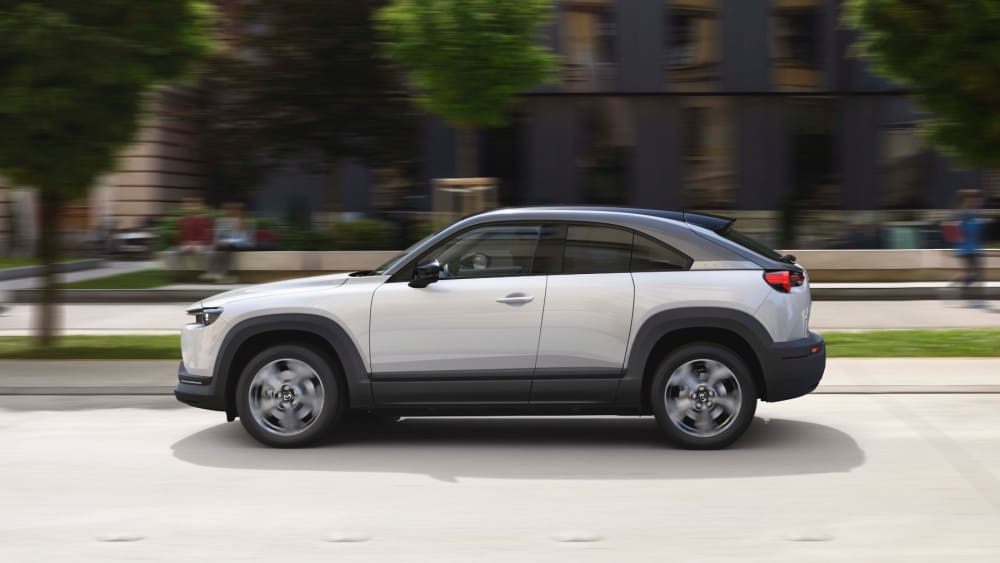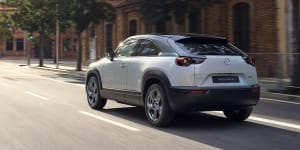Information and electric vehicles of the [object Object] brand

![[object Object] logo](https://res.cloudinary.com/donyiousk/image/upload/w_80/f_auto/c_scale,w_1400/v1/car/dccczh021a0jpigy5fpm)
Mazda
Breathe easy, drive electric.



Mazda electric vehicles
What makes Mazda EVs different from other brands?+
Mazda EVs do have some distinct characteristics that set them apart from other brands in the electric vehicle market. Here are some key points to consider:
Focus on driving experience: Mazda prioritizes a fun and engaging driving experience in their EVs, just like their gasoline-powered cars. This translates to features like:
- Rear-wheel-drive layout: This is uncommon in EVs, but Mazda believes it provides a more natural and dynamic driving feel. Their current EV, the MX-30, offers a front-wheel-drive option as well.
- Zoom-Zoom philosophy: Mazda's focus on driving dynamics extends to things like responsive handling, precise steering, and a comfortable ride quality.
- Rotary engine range extender optional in MX-30: This unique feature addresses range anxiety by adding a small rotary engine that acts as a generator to charge the battery when needed. This can be a good option for drivers who don't have easy access to charging or frequently take long trips.
Unique design: Mazda EVs have a distinct and stylish design language that stands out from the crowd. The MX-30, for example, has a crossover coupe shape with suicide doors and a minimalist interior.
Focus on sustainability: While not exclusive to Mazda, they do emphasize using recycled materials and sustainable production practices in their EVs.
Limited model lineup: Currently, Mazda only offers one EV model, the MX-30. This is in contrast to some other brands that have a wider range of EVs to choose from. However, Mazda is expected to introduce more EV models in the future.
Here's a table summarizing the key differences:
| Feature | Mazda EVs | Other Brands |
|---|---|---|
| Driving focus | Fun and engaging | Varies, but often prioritizes efficiency and practicality |
| Drivetrain layout | Rear-wheel-drive optional FWD | Mostly front-wheel-drive, some AWD options |
| Design | Unique and stylish | Varies, but often more conservative |
| Sustainability | Emphasis on recycled materials and sustainable practices | Varies, but becoming increasingly important |
| Model lineup | Limited currently only MX-30 | Wider range of options |
Ultimately, the best way to decide if a Mazda EV is right for you is to take one for a test drive and see if it lives up to your expectations.
What are the different models of Mazda EVs available?+
As of today, October 26, 2023, Mazda only offers one fully electric vehicle model, the MX-30. However, they do have several plug-in hybrid models available. Here's a breakdown:
Fully Electric Vehicles:
- Mazda MX-30: This stylish and compact SUV has a starting price of $24,995 in the US. It has a 107-horsepower electric motor and a 121-mile range. The MX-30 also has a unique freestyle door design with rear-hinged suicide doors.
Plug-in Hybrid Vehicles:
- Mazda CX-30 PHEV: This plug-in hybrid version of the CX-30 has a starting price of $28,995. It has a 250-horsepower engine and a combined electric and gas range of 360 miles.
- Mazda CX-5 PHEV: This plug-in hybrid version of the CX-5 has a starting price of $36,995. It has a 257-horsepower engine and a combined electric and gas range of 360 miles.
- Mazda CX-90 PHEV: This brand-new three-row plug-in hybrid SUV has a starting price of $49,945. It has a 323-horsepower engine and a combined electric and gas range of 420 miles.
It's important to note that the availability of these models may vary depending on your location. Additionally, Mazda is committed to electrifying its lineup in the future, so we can expect to see more EV and PHEV models from them in the coming years.
How much do Mazda EVs cost?+
As of today, December 28, 2023, Mazda only offers one fully electric vehicle, the MX-30. Its price varies depending on the specific trim level and location:
US market:
- Base trim: Starts at $35,385, including a $1,275 destination charge.
- Sport Lux trim: Costs slightly more than the base model, offering additional features like power seats and smart keyless entry.
UK market:
- First Edition: Starts at £27,495, with various paint options affecting the final price.
- Sport Lux: Priced at £27,545, also with optional paint colors.
It's important to note that:
- Availability: The MX-30 is not currently available in all markets. For example, it is only sold in California within the US.
- Additional costs: These prices don't include any potential government incentives or taxes that may apply in your region.
- Future models: Mazda plans to launch more EVs in the coming years, so the price range will likely expand.
If you'd like to explore specific pricing details for your location, you can check the official Mazda website for your country or visit a local dealership.
What is the range of Mazda EVs?+
As of today, October 26, 2023, Mazda only has one fully electric vehicle available, the MX-30. Its range varies depending on factors like driving conditions, weather, and energy usage. Here's a breakdown:
Official EPA estimated range:
- Combined: 92 miles 148 km
Real-world range estimates:
- 120 - 250 km 75 - 155 miles depending on conditions.
- Cold weather with heating can dramatically reduce the range.
- Highway driving at high speeds also consumes more energy and reduces range.
Some important points to consider:
- The MX-30's range is significantly lower than most other popular EVs on the market, which typically offer 200-300 miles or more.
- This limited range may not be suitable for everyone, especially those who regularly need to travel long distances or frequently go on road trips.
- However, the MX-30 does have some advantages, such as its stylish design, fun driving dynamics, and relatively affordable price.
Additionally:
- Mazda also offers plug-in hybrid electric vehicles PHEVs like the CX-60 PHEV and CX-90 PHEV. These vehicles have longer ranges thanks to their gasoline engines, but they also emit emissions when using the engine.
- Mazda is planning to introduce more EVs in the future, with longer ranges expected.
Overall, the range of Mazda EVs is currently limited, but it's important to consider your individual needs and priorities when making a decision. If you need a long-range EV, there are many other options available from other manufacturers. However, if you're looking for a stylish and fun EV with a shorter range that fits your budget, the MX-30 could be a good option.
How long does it take to charge a Mazda EV?+
Unfortunately, there's no one-size-fits-all answer to your question about charging a Mazda EV. The charging time depends on several factors, including:
1. Mazda EV model: Mazda offers both fully electric vehicles BEVs) and plug-in hybrid electric vehicles (PHEVs. BEVs have larger batteries and generally take longer to charge than PHEVs. For example, the Mazda MX-30 BEV has a 35.5 kWh battery and can take 4-10 hours to fully charge on Level 2 charging, while the CX-90 PHEV has a 17.8 kWh battery and can be fully charged in 5-6 hours on Level 1 or 1-2 hours on Level 2.
2. Charging level: There are three main charging levels for electric vehicles:
- Level 1: Uses a standard 120-volt outlet, similar to the one you use to charge your laptop. This is the slowest option, taking days to fully charge an EV.
- Level 2: Uses a 240-volt outlet, similar to the one you use for your dryer. This is the most common home charging option and can fully charge an EV in several hours.
- DC fast charging: Uses a high-voltage DC current from specialized charging stations. This is the fastest option, often taking 30 minutes or less to charge an EV from 20% to 80%.
3. Battery percentage: The amount of time it takes to charge an EV also depends on how much battery is already charged. For example, charging from 20% to 80% will be much faster than charging from 0% to 100%.
4. Other factors: Ambient temperature, the health of the battery, and even the specific charger you're using can also affect charging times.
To give you a more specific answer, I'd need to know which Mazda EV you're interested in and what charging level you're using. Once I have that information, I can tell you how long it takes to fully charge the battery or add a certain amount of range.
Here are some helpful resources that you can use to find charging times for different Mazda EVs:
- Mazda USA website: Link
- Mazda Europe website: Link
- PlugShare app: Link
What are the maintenance requirements for a Mazda EV?+
Mazda EVs, like most electric vehicles, require less maintenance than their gasoline-powered counterparts. However, they still have some important needs to keep them running smoothly and safely. Here's a breakdown of the key maintenance aspects:
Reduced Needs:
- No oil changes: EVs ditch the combustion engine, eliminating the need for regular oil changes and filter replacements.
- Less wear and tear: The electric motor has fewer moving parts compared to an internal combustion engine, leading to less wear and tear and potentially fewer parts replacements.
- Extended brake life: Regenerative braking in EVs helps recharge the battery while also slowing the car down, reducing wear on the traditional friction brakes.
Essential Checks and Services:
- Battery system: While robust, the battery pack still needs monitoring. Mazda recommends annual checks of the cooling system, battery health, and software updates to ensure optimal performance and longevity.
- Tires: Regular tire inspections and rotations are crucial, just like gasoline cars, to optimize wear and ensure safety.
- Brakes: While regenerative braking reduces wear, the traditional brakes still need regular inspection and fluid changes at prescribed intervals as outlined in your owner's manual.
- Cabin air filter: Similar to gas cars, replacing the cabin air filter ensures clean air inside the vehicle, improving comfort and potentially reducing cabin noise.
- Wiper blades and fluid: Maintain visibility by checking and replacing wiper blades and fluid as needed.
- Lights and turn signals: Ensure all lights and turn signals are functioning properly for safety.
Additional Points:
- Scheduled maintenance: Mazda offers a complimentary 2-year/32,000km scheduled maintenance plan for new MX-30 EVs, covering essential checks and services. Refer to your owner's manual for specific intervals and details.
- MyMazda app: The MyMazda app can send notifications for upcoming maintenance services and provide vehicle health information.
- Extreme conditions: Frequent operation in extreme hot or cold temperatures can affect battery performance. Consider adjusting charging habits and driving behavior accordingly to optimize battery health.
Overall, Mazda EVs require less frequent and generally less expensive maintenance compared to gasoline cars. By following the recommended checks and services, you can enjoy a smooth and reliable driving experience for years to come.
Does Mazda offer any tax credits or incentives for purchasing an EV?+
While Mazda itself does not offer any specific tax credits or incentives for purchasing an EV, you may still be eligible for federal tax credits. Here's the breakdown:
Federal Tax Credits:
- New EVs: All-electric, plug-in hybrid, and fuel cell electric vehicles purchased new in 2023 or after may be eligible for a federal income tax credit of up to $7,500. However, eligibility depends on several factors:
- MSRP: The vehicle's MSRP must be below $80,000 for an SUV and $55,000 for a sedan, wagon, or hatchback.
- Assembly location: The vehicle must be manufactured in North America.
- Battery and critical minerals: Specific requirements regarding the battery components and critical mineral sourcing must be met.
- Modified adjusted gross income AGI: The credit value may be phased out based on your income level.
- Used EVs: You may also be eligible for a tax credit of up to $4,000 for a used electric vehicle purchased from a dealer for $25,000 or less. The credit amount is equal to 30% of the purchase price, with a maximum of $4,000.
Here are some resources to help you check if you qualify for the federal tax credits:
- Fuel Economy website: Link
- Consumer Reports: Link
Mazda EV Models:
Mazda currently offers only one fully electric vehicle, the MX-30. Additionally, they have plug-in hybrid versions of some of their existing models. However, as of October 2023, Mazda vehicles no longer qualify for the full $7,500 federal tax credit due to exceeding the manufacturer phase-out limit. Some states and local governments may offer additional incentives for EV purchases, so it's worth checking with your local authorities.
Overall, while Mazda itself doesn't offer specific tax credits, you may still be eligible for federal and state/local incentives depending on the EV model, your purchase location, and income level.
What is the warranty on a Mazda EV?+
Mazda's EV warranty coverage actually varies depending on the specific model and your location, so we need some more information to get you the exact details. Here's what I can tell you so far:
General EV Warranty:
- All Mazda EVs come with a standard 3-year/36,000-mile New-Vehicle Limited Warranty that covers defects in materials and workmanship for all parts supplied by Mazda.
- Additionally, they offer the Mazda Unlimited program, which includes:
- 3-year/unlimited mileage Powertrain Warranty
- 5-year/unlimited mileage Corrosion Warranty
- 7-year/unlimited mileage Anti-Perforation Warranty
- 3-year Roadside Assistance
High Voltage Battery Warranty:
- This is where things get specific. The duration of the battery warranty depends on the model and where you live:
- Mazda MX-30: 8 years or 100,000 miles globally
- CX-90 PHEV: 96 months or 100,000 miles in states with Zero Emission Vehicle standards
- Other models: May have different battery warranty terms, so it's best to check the specific model details.
Resources for more information:
- Mazda USA website: Link
- Mazda Canada website: Link
- Mazda UK website: Link
To get the most accurate information, please tell me which specific Mazda EV model you're interested in and your location country and state/province.- With that information, I can provide you with the exact warranty details for your situation.
Where can I learn more about Mazda EVs?+
There are several ways you can learn more about Mazda EVs:
Official Mazda Websites:
- Mazda USA: You can find information about all their current EV offerings, including the MX-30 and the CX-90 PHEV, on their website. They also have sections on types of EVs, their impact, and why you might choose a Mazda EV: Link
- Mazda UK: If you're located in the UK, their website offers specific information about the MX-30, including details on its design, features, and specs: Link
News and Reviews:
- InsideEVs: This website is a great resource for all things electric vehicles, including news, reviews, and comparisons. They have several articles about Mazda EVs, including their latest announcement of a new EV in 2025: Link
- Car and Driver: This popular car magazine also has a section dedicated to electric vehicles, with reviews and comparisons of different models. They have reviews of both the MX-30 and the CX-90 PHEV: Link
YouTube Videos:
- There are many YouTube channels that review and compare electric vehicles. Here are a few popular ones that have videos on Mazda EVs:
- Doug Demuro: Link
- Redline Reviews: Link
- Autogefühl: Link
Local Mazda Dealerships:
- Your local Mazda dealership can also be a great resource for information about their EVs. They can answer your questions, let you take a test drive, and provide you with more information about specific models.
No matter which method you choose, I hope you find the information you're looking for!
Additional Tips:
- Consider your needs and budget: When researching EVs, it's important to consider your needs and budget. Think about how you'll be using the car, how much range you need, and how much you're willing to spend.
- Compare different models: Once you've narrowed down your options, be sure to compare different models to see which one is the best fit for you. Consider factors such as range, features, price, and reviews.
- Take a test drive: Before making a decision, be sure to take a test drive of the EV you're interested in. This will give you a chance to see how it feels to drive and whether it's the right size for you.





































